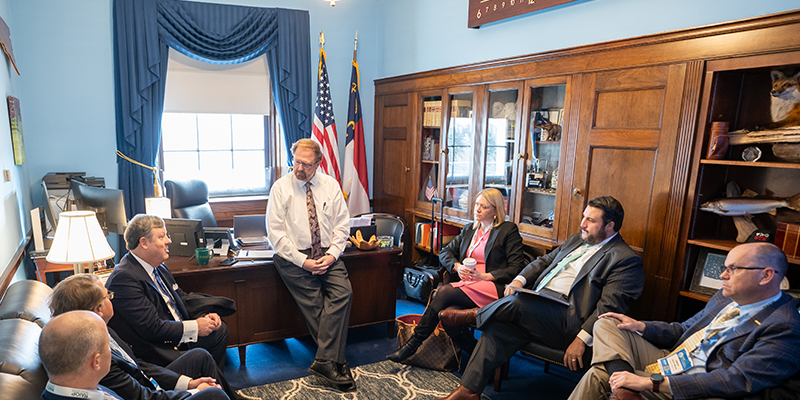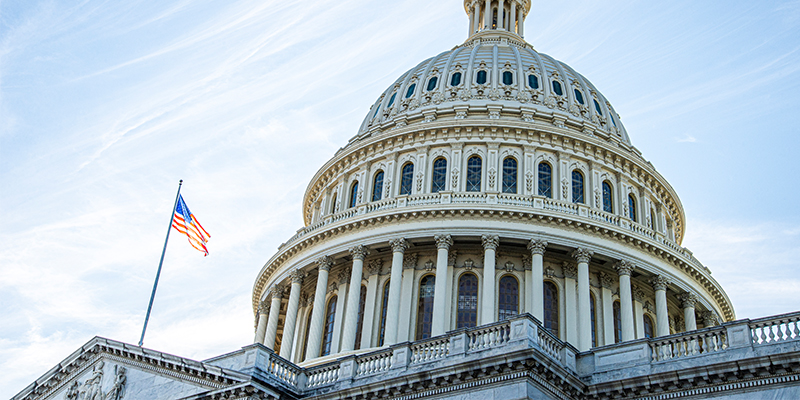The Kansas City Chiefs may be the champions of the National Football League, but NAIOP’s chapters were doing a little championing of their own: on behalf of the industry in Congress. Last week, hundreds of NAIOP members from the U.S. and Canada attended NAIOP’s Chapter Leadership and Legislative Retreat (CL&LR) in Washington, D.C., with the conference culminating in countless meetings with their elected representatives to advocate on behalf of the commercial real estate industry. And while, admittedly, the comparison might be a little bit of a stretch, there was a real-life Super Bowl connection: members from NAIOP Utah who met with one of their congressmen, Burgess Owens, got to wear his Super Bowl ring, won when he played for the Oakland Raiders in Super Bowl XV.
That was only one of the meetings that NAIOP members had on Capitol Hill to talk about NAIOP’s top public policy and legislative priorities for 2024:
- Adaptive Reuse. The aftermath of the COVID-19 pandemic and the resulting work-from-home trends have led to high vacancy rates and underutilization of commercial structures in many communities with severe economic consequences. Depressed market values for underutilized structures mean lower property taxes and taxes from property sales; and less employee foot traffic in communities results in lower sales taxes from reduced economic activity. While Class A buildings remain competitive, many Class B and C buildings with high vacancy rates are unlikely to return to prior occupancy levels. Many of these buildings could be adapted for residential usage, helping to address housing shortage, but financial and other factors present barriers to property conversions.
Congress should pass legislation to incentivize the adaptive reuse of vacant and underutilized commercial buildings. NAIOP’s Ohio chapters were instrumental in getting Representative Mike Carey (R-OH), a member of the House Ways and Means Committee, to develop draft legislation creating a federal tax incentive to spur these property conversions. The bill would create a 20% tax credit for the costs of converting an existing commercial structure to residential, with certain percentages of the units set aside for affordable housing. Discussions are ongoing with potential Democratic cosponsors for the legislation, which is expected to be introduced in the next few weeks. - Capital and Credit. Credit availability for commercial real estate has become severely constrained for a number of reasons. From March 2022 through July 2023, the Federal Reserve raised interest rates 11 times, the steepest increase in 40 years. Interest rates rose from nearly 0 to 5%. As a result, commercial property owners needing to refinance their debt are facing sharply increased debt servicing costs, at a time of reduced office occupancy levels across the nation, higher costs due to inflation, and reduced property values. Unsurprisingly, federal financial regulators have been encouraging banks to reduce their exposure to commercial real estate as a result.
Total commercial real estate debt exceeds $6 trillion, and banks hold approximately 50% of that debt. In the next two years, more than $1 trillion will mature and need to be refinanced at much higher rates. The constrained levels of bank lending will create potential risks for the U.S. economy and financial system. At the same time, the Federal Reserve is considering additional regulations, known as the Basel III Endgame Regulations, which would increase the capital requirements on major U.S. banks, further curtailing their ability to provide needed financing to commercial real estate. - Tax Policy. Many of the current provisions in the tax code important to commercial real estate originally include in the Tax Cuts and Jobs Act of 2017 (TCJA) will expire in 2025 unless renewed by Congress. Some of these include lower capital gains tax rates, the 20% deduction for real estate partnerships and other pass-through entities, deductibility of interest on business debt, and favorable depreciation provisions. In addition, the Biden administration and some members of Congress have proposed severely restricting the use of Section 1031 like-kind exchanges, ending capital gains tax treatment for real estate carried interests, and substantially increasing capital gains taxes on estate property.
The education that NAIOP chapters provide their members of Congress during their Hill visits on the important economic contribution of commercial real estate in their districts and states is critical to ensuring the continuation of favorable tax policy. Commercial real estate contributes $2.5 trillion to U.S. GDP, $881.4 billion in personal earnings, and supports 15 million jobs, according to the 2024 NAIOP Research Foundation Report. Included in the advocacy materials for each chapter were individualized state reports showing the contributions made by the industry in those states.
NAIOP members and their chapter leadership provide an important service for the industry when they meet with their elected policy makers. While they are here, of course, CL&LR attendees got the opportunity to listen to experienced political analysts such as Chris Cillizza discuss the 2024 presidential election, among other things. They also heard from experts on important issues affecting the industry, such as the role of states in building transportation electrification infrastructure. But the impact made by NAIOP’s dedicated members and chapter executives in advocating for the industry during their CL&LR congressional visits lasts beyond the conference and ensures that our voice is heard on Capitol Hill.














